|
|

ISM monitors router status according to the monitoring intervals and performance thresholds that you can specify and provides alerts for problem conditions. In addition, ISM enables you to quickly go to the panel that provides you with the best information about the detected router condition so that you can quickly diagnose the source of the problem.
This chapter describes the following tasks to help you monitor your network routers in ISM:
Once you have enabled the Router Management application in ISM, you can disable monitoring of individual routers (including their associated CMCCs and DSPUs) when you set up the router monitoring options.
For information on setting up router-specific management options, see the section "Setting Up the Router Monitoring Options" in this chapter.
Complete the following tasks to set up ISM to manage routers and their resources:
Step 1 On the ISM main menu panel (Figure 5-1), press the Tab key until the cursor is located on the * SETUP option and press Enter.
The first ISM Router Management Setup panel is displayed (Figure 5-2).
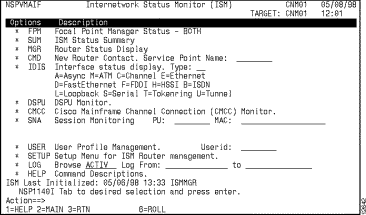
 Timesaver To go directly to the ISM Router Management Setup panel, type the ismsetup command at any ISM command prompt and press Enter.
Timesaver To go directly to the ISM Router Management Setup panel, type the ismsetup command at any ISM command prompt and press Enter.
Step 2 In the Router Management option, type Y in the Update column. Yes appears in the Update column beside the Router Management option. This is the default selection.
The Router Status Display option (* MGR) will appear on the ISM main menu panel (Figure 5-1) with an asterisk beside it to indicate that the Router Management application is enabled for all routers.
The ISM Status Summary (* SUM), New Router Contact (* CMD), DSPU Monitor (* DSPU), and CMCC Monitor (* CMCC) options are also enabled. (You can disable these applications individually.)

Step 3 To continue setting up other global router monitoring options, press F8.
For information about setting up the global router monitoring options, see the section "Setting Up Global Router Monitoring Options" in this chapter.
Step 4 When you have completed specifying the options, press F2 to return to the first ISM Router Management Setup panel (Figure 5-2).
Step 5 In the Change Type option, type 2 for Update.
Step 6 In the Action Type option, do one of the following tasks to enable router monitoring and the other setup options that you specified:
Step 7 To confirm the options that you selected, press Enter.
If the router is already connected to the mainframe and communicating with VTAM, you can choose one of two options to create the new router definition:
When ISM detects a new router, it recognizes and establishes the VTAM definition member and major node for the router record in ISM. This information is necessary for successful monitoring of the router.
Use the following procedure to create a new router definition for a router that has not already been discovered by ISM:
DIS router_service_point
Step 2 Verify that the router is active to VTAM as shown in Figure 5-3. Your display might vary slightly depending upon the configuration of your router.
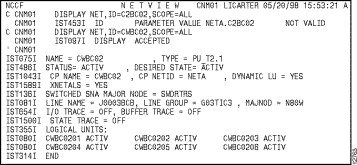
Step 3 To initiate ISM's discovery of the router, go to the ISM main menu panel (Figure 5-4) and press the Tab key until the cursor is positioned on the Service Point Name field for the * CMD New Router Contact option. Type the service point name of the router that you want to add and press Enter.
The Router Command Interface panel (Figure 5-5) is displayed for the router service point that you specified.
 Timesaver Type the ismr router_service_point command at any ISM command prompt and press Enter to add the new router service point and go directly to the Router Status with Options panel.
Timesaver Type the ismr router_service_point command at any ISM command prompt and press Enter to add the new router service point and go directly to the Router Status with Options panel.

Step 4 Verify that the Hostname field contains a valid router host name and that it does not contain INVALID or UNKNOWN. If the host name contains a valid router name, then ISM has successfully communicated with the router and the router and its resources can be monitored.
If the host-name value is INVALID or UNKNOWN, then the router is not available to ISM and you need to verify your router installation in VTAM. For more information, see the chapter "Configuring the Mainframe-to-Router Link" in the CiscoWorks Blue Internetwork Status Monitor Installation Guide.
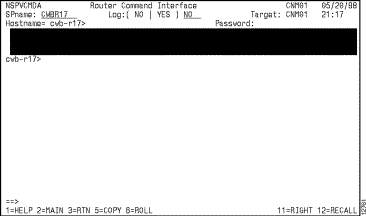
To verify the router definition and collect statistics for the router, complete the following steps:
Step 1 To return to the ISM main menu panel, press F2.
Step 2 Press the Tab key until the cursor is positioned on the * MGR option and press Enter.
The Router Status panel is displayed (Figure 5-6).

Step 3 Position the cursor on the SPname of the router that you added in Step 3 and press F10.
The Router Status with Options panel is displayed (Figure 5-7).
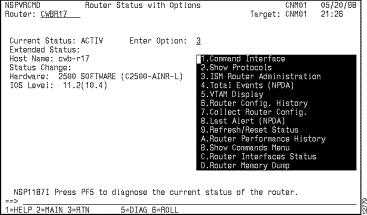
Step 4 To display the ISM Router Administration panel (Figure 5-8), type 3 in the Enter Option field of the Router Status with Options panel and press Enter.
The ISM Router Administration panel is displayed. The Description field contains the text "Dynamically Added" and the VTAM Definition Member and Major Node values are shown in the record. ISM automatically collects initial statistics for the router.

Step 5 You can modify the router monitoring options and then press F4 to update the record.
For more information about specifying the router monitoring options, see the section "Setting Up the Router Monitoring Options" in this chapter.
Use the ISM Router Management Setup panels to perform the following tasks for setting up global router management options:
For detailed information about how to access and set up the global ISM router monitoring options, see the section "Setting Up ISM Router Management" in the "Setting Up the ISM Environment" chapter.
There are two methods that you can use to set up monitoring for specific routers based on the number of routers that you want to update at one time:
You can use either method when performing the following tasks to specify router management options for individual routers known to ISM:
To set up router monitoring options for several routers at one time, complete the following steps:
Step 1 From the ISM main panel, press the Tab key until the cursor is positioned on the * SETUP option and press Enter.
The ISM Router Management Setup panel is displayed.
Step 2 Press the Tab key until the cursor is positioned on the Enter YES to update field for the Router Monitor Setup option. Type Yes and press Enter.
The Router Management Settings panel is displayed (Figure 5-9). This panel lists all of the routers that are known to ISM in a column on the left side of the panel.
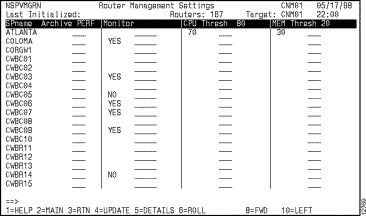
Step 3 Press F11 to display the second part of the Router Management Settings panel (Figure 5-10).
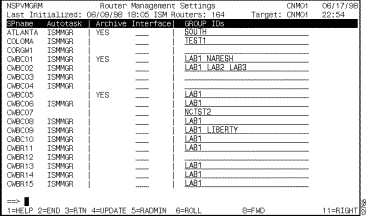
Step 4 Locate the service point name of the routers that you want to update. If necessary, press F8 to show additional records.
Step 5 To confirm the options that you selected, press Enter.
Step 6 To update the ISM router management setup definition for the routers that you modified, press F4.
To set up router monitoring for an individual router, complete the following steps:
Step 1 From the ISM main menu panel, press the Tab key until the cursor is positioned on the * MGR option and press Enter.
The Router Status panel is displayed.
 Timesaver Type the ismmgr command at any ISM command prompt and press Enter to go directly to the Router Status panel.
Timesaver Type the ismmgr command at any ISM command prompt and press Enter to go directly to the Router Status panel.
Step 2 Position the cursor on the SPname of the router that you want to modify and press F10.
The Router Status with Options panel is displayed.
Step 3 Type 3 in the Enter Option field and press Enter.
The ISM Router Administration panel is displayed (Figure 5-8).
Step 4 To confirm the options that you selected, press Enter.
Step 5 In the Change Type option, type 2.
Step 6 In the Action Type option, do one of the following to enable the ISM router management setup options that you specified:
You can set up router monitoring for an individual router using one of the following methods:
For more information on updating individual router definitions, see the section "Setting Up Individual Router Monitoring Options" in this chapter.
The amount of time that the ISM monitoring autotask waits to contact routers to collect statistics and update status is specified on a global basis for all routers on the second ISM Router Management Setup panel (Figure 5-11). The default monitoring interval is 15 minutes.

You can modify this monitoring interval for all routers on the ISM Router Management Setup panel. Or, if you want to balance the monitoring load among a large number of routers being managed by ISM, you can assign your routers to groups and use the ISM Scheduler application to set up monitoring intervals for every router group.
For more information about setting up the router monitoring intervals, see the sections "Setting Up ISM Router Management" and "Setting Up the Router Monitoring Schedules" in the "Setting Up the ISM Environment" chapter.
If threshold settings are specified, it means that ISM indicates a performance alert (status is PERF) for the router when the following conditions occur:
You can set up the CPU and memory thresholds for all routers on the second ISM Router Management Setup panel (Figure 5-10). For more information about setting up the global router management options, see the section "Setting Up ISM Router Management" in the "Setting Up the ISM Environment" chapter.
For more information on updating individual router definitions, see the section "Setting Up Individual Router Monitoring Options" in this chapter.
For more information about enabling the ISM Interface Monitoring application and selecting the types of interfaces for ISM to monitor, see the section "Setting Up ISM Router Management" in the "Setting Up the ISM Environment" chapter.
You can set up router interface archiving for an individual router using one of the following methods:
For more information on updating individual router definitions, see the section "Setting Up Individual Router Monitoring Options" in this chapter. For more information about monitoring interfaces, see the "Monitoring Interfaces" chapter.
If you assign a router to more than one group and also set up the ISM Scheduler application, then ISM monitors the router according to the monitoring interval associated with the first group to which the router is assigned. The order in which you specify a group ID for a router affects the implementation of group scheduling.
You can assign routers to management groups using one of the following methods:
For more information on updating individual router definitions, see the section "Setting Up Individual Router Monitoring Options" in this chapter.
You must be an operator with ISM enable authority to enable router alert generation or modify other ISM rules.
Complete the following tasks to set up router alert generation for performance and memory thresholds and router status:
Step 1 From the ISM main menu panel, press the Tab key until the cursor is positioned on the * SETUP option and press Enter.
The ISM Router Management Setup panel is displayed.
 Timesaver To go directly to the ISM Router Management Setup panel, type the ismsetup command at any ISM command prompt and press Enter.
Timesaver To go directly to the ISM Router Management Setup panel, type the ismsetup command at any ISM command prompt and press Enter.
Step 2 In the Rule Update/Change option, type Yes and press Enter.
The ISM Management Rules Setup panel is displayed (Figure 5-12).
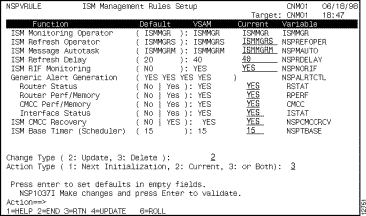
Step 3 To enable alerts for router hardware status conditions, type Yes in the Router Status option under Generic Alert Generation.
Step 4 To enable alerts for router performance and memory conditions, type Yes in the Router Perf/Memory option under Generic Alert Generation.
Step 5 In the Change Type option, type 2 for Update.
Step 6 In the Action Type option, do one of the following:
Step 7 To confirm the options that you selected, press Enter.
Step 8 To update the ISM management definition according to the Change Type and Action Type options that you selected, press F4.
You can disable archiving of history and performance data using one of the following methods:
For more information on updating individual router definitions, see the section "Setting Up Individual Router Monitoring Options" in this chapter.
You can remove the history and performance records for an individual router from the history database using the Reset Performance History option on the ISM Router Administration panel (Figure 5-8). When you enable the Reset Performance History option, the history records are removed from the database when you press F4 to update.
You can use this option to update the record wrap counts when ISM reinitializes the history file. The record wrap counts are specified on the Router Management Constants Setup panel (Figure 3-5). For more information on specifying the wrap counts, see the section "Setting Up ISM Router Management" in the "Setting Up the ISM Environment" chapter.
Complete the following tasks to delete history and performance records for an individual router:
Step 1 On the ISM Router Administration panel (Figure 5-8), type Yes in the Reset Performance History option.
Step 2 In the Change Type option, type 2 for Update.
Step 3 To confirm the options that you selected, press Enter.
Step 4 To delete the performance history data, press F4.
You can also change the maximum number of records that the database contains before overwriting the data contents. The wrap counts are set for all routers and interfaces. When these values are changed after initializing ISM, the new values will apply to new routers and interfaces defined to ISM. You can apply the new values to existing resources if you reset the history for an individual router or interface. After you reset the history records, the next time that the file is initialized the new values will be used.
For more information on resetting the history database, see the section "Deleting History and Performance Records" in this chapter. Another method of applying changed wrap counts to previously defined routers and interfaces is to delete the router definition and redefine the router to ISM.
For more information about changing the global constants, see the section "Setting Up ISM Router Management" in the "Setting Up the ISM Environment" chapter.
ISM provides two primary panels where you can monitor the status of your routers:
Use the ISM Status Summary panel (Figure 5-13) to monitor the overall status of all your routers by type of condition. The ISM Status Summary panel uses a color-coded display to indicate different types of status conditions. New alerts are shown in a colored box. After routers with new alerts have been viewed by an operator, or if you leave the ISM Status Summary panel, the colored box is removed. The number in the column representing the number of routers in that condition will remain color-coded unless the status condition has been removed.
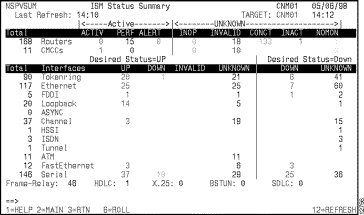
You can perform the following operations to access other information when monitoring routers using the ISM Status Summary panel:
To view router status and diagnose router problems, use the Router Status panel (Figure 5-14). To access the Router Status panel, use the * MGR option on the ISM main menu panel or select a router on the ISM Status Summary panel and press Enter.
You can perform the following tasks on the Router Status panel:

To display additional information about the status of the routers in your network from the Router Status panel (Figure 5-14), press F9. The Router Status Extended panel is displayed (Figure 5-15).
The Router Status Extended panel provides the following additional information about the routers on the network:
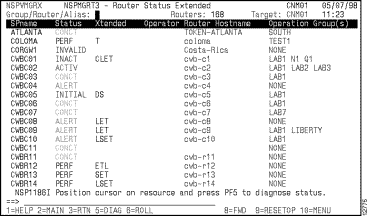
The color of the service point name of a router on the ISM Status Summary panel (Figure 5-13) or Router Status panel (Figure 5-14) indicates the condition of that router.
Table 5-1 lists the color and definition of each status.
| Color | Status | Definition |
| Green | ACTIV | ISM can communicate with the router and the router is ready to receive commands. |
| Red | CONCT | Router is not connected to VTAM. |
| Red | INOP | Router failed to respond when a RUNCMD was issued, perhaps because the router has been made inactive by an operator. If a router is in an inactive state, a System Services Control Point (SSCP)-to-PU session cannot be established. An operator must first activate the router by issuing the NetView ACT command. |
| Yellow | PERF | The router is active, but ISM has detected a performance-related problem for the CPU or memory utilization thresholds, or an interface configured in the router is down. |
| Pink | ALERT | The router is active, but an alert was detected through the NetView automation table for a router resource managed by the router control point. |
| Turquoise | INVALID | Service point is unknown to VTAM. VTAM definition does not exist. |
| Turquoise | INACT | An operator has inactivated the router in VTAM. |
| Reverse | nnnnn | An operator is enabled to the router. |
| Blue | NOMON | Router monitoring is disabled for the router. |
ISM provides a powerful diagnostic function that you can use to obtain information about the most critical problem affecting the router. From the Router Status panel (Figure 5-14), the Router Status with Options panel (Figure 5-7), or the Router Status Extended panel (Figure 5-15), you can press F5 to display the diagnostic panel that ISM determines is best-suited to solve the router's most critical problem.
For example, if an alert has been received from a router (router is displayed in pink and has an ALERT status), then you can select the router and press F5 to display the appropriate panel to view the received alerts for that router. If the problem is a hardware related problem, then ISM might open NPDA to show hardware status information from NetView.
To quickly diagnose router problems on the Router Status panel or Router Status with Options panel, position the cursor on the router that you want to diagnose and press F5.
You can apply filters based upon the following criteria:
Group filtering allows you to view the status for logically grouped routers. For example, a group may include all the routers located in a region or department, or those of a particular device type. The group to which a router belongs is assigned by an ISM administrator when the router is defined to ISM, and only an ISM administrator can filter routers by groups. For more information about assigning routers to groups, see the section "Assigning Routers to Management Groups" in this chapter.
To include filters for up to two router groups on the ISM status panels, complete the following steps:
Step 1 From the ISM main menu panel (Figure 5-1), press the Tab key until the cursor is positioned on the * USER option and press Enter.
The ISM User Administration panel is displayed (Figure 5-16).
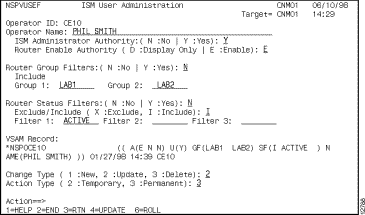
 Timesaver To go directly to the ISM User Administration panel, type the ismuser command at any ISM command prompt and press Enter.
Timesaver To go directly to the ISM User Administration panel, type the ismuser command at any ISM command prompt and press Enter.
Step 2 In the Group Filters option, type Y.
Step 3 In the Group 1 and Group 2 options, specify the router group names that you want to include when viewing the ISM router status displays.
Step 4 In the Change Type option, type 2 for Update.
Step 5 In the Action Type option, do one of the following:
Step 6 To confirm the options that you selected, press Enter.
Step 7 To update the ISM user definition according to the Change Type and Action Type options that you selected, press F4.
Step 8 View the ISM status panels to see only the resources defined to the groups that you selected.
To view a logical group of routers from the Router Status or Router Status Extended panels, in the Group/Router/Alias option at the top of the panel, type the name of the router groups that you want to view and press Enter.
The routers that belong to the filter groups that you specified are displayed.
Figure 5-17 and Figure 5-18 show examples of filtering for routers assigned to the group LAB1.
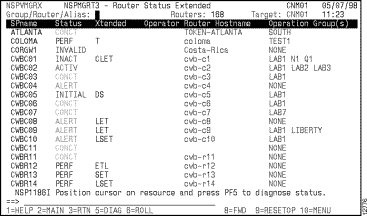
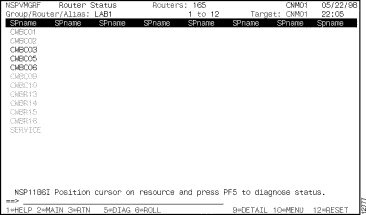
 Tips
Tips
You can determine the group to which a router belongs from the Router Status Extended panel (Figure 5-15) or by viewing the administration data of a router (Figure 5-8 and Figure 5-9).
Status filtering allows you to view status for routers that match, or do not match, a specified status. You can specify filtering of routers that match up to three different status types, and then display a Router Status panel view that includes or excludes those routers. For more information on the statuses by which you can filter routers, see Table 5-1.
To include or exclude routers that match the filter criteria (up to three status types) for viewing on the ISM status panels, complete the following steps:
Step 1 From the ISM main menu panel, press the Tab key until the cursor is positioned on the * USER option and press Enter.
The ISM User Administration panel is displayed.
 Timesaver To go directly to the ISM User Administration panel, type the ismuser command at any ISM command prompt and press Enter.
Timesaver To go directly to the ISM User Administration panel, type the ismuser command at any ISM command prompt and press Enter.
Step 2 In the Status Filters option, type Y.
Step 3 In the Exclude/Include option, do one of the following:
Step 4 In the Filter 1, Filter 2, and Filter 3 options, specify the router status types that you want to include or exclude when viewing the ISM router status displays.
Step 5 In the Change Type option, type 2 for Update.
Step 6 In the Action Type option, do one of the following:
Step 7 To confirm the options that you selected, press Enter.
Step 8 To update the ISM user definition according to the Change Type and Action Type options that you selected, press F4.
 Tips
Tips
Use the ISM Status Summary panel (Figure 5-13) to quickly filter routers of a single status type and view them on the Router Status panel. To do this, press the Tab key until the cursor is positioned on the routers of a particular status type and press Enter.
To filter routers by service point name from the Router Status or Router Status Extended panels, in the Group/Router/Alias option at the top of the panel, type the beginning characters of the service point name that you want to view followed by an asterisk to allow a match for any remaining characters in the name, and press Enter. Only the routers with service point names that begin with the same characters you specified are displayed. For example, to filter the display of all routers beginning with the characters cwb, type cwb* in the Group/Router/Alias option.
If you are an enabled ISM user, you can release and reset a router from an operator who is logged in to a router in enabled mode or who is in a busy state with a router.
To refresh outdated router status information, press F12. Another method that you can use to reset and check the status of a router, is to select the router and press F10 to display the Router Status with Options panel. In the Enter Option field, type 9 and press Enter.
You can reset a session between an operator and a router from the Router Status Extended panel.
Complete the following tasks to reset a session between an operator and a router:
Step 1 From the Router Status panel, press F9. The Router Status Extended panel is displayed.
Step 2 Position the cursor over the service point name of the router that you want to reset, and press F9.
Complete the following tasks to view a router as it is defined in VTAM:
Step 1 On the Router Status panel, position the cursor over the router name and press F10. The Router Status with Options panel is displayed.
Step 2 In the Enter Option field, type 5 and press Enter. The router configuration as it is defined in VTAM is displayed (Figure 5-19).
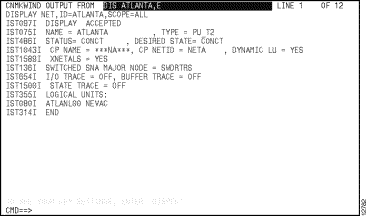
Complete the following tasks to view a router as it is defined in ISM:
Step 1 On the Router Status panel, position the cursor over the router name for which you want to view ISM management information and press F10. The Router Status with Options panel is displayed.
Step 2 In the Enter Option field, type 3 and press Enter. The ISM Router Administration panel is displayed.
Complete the following tasks to collect the current configuration of a router:
Step 1 On the Router Status panel, position the cursor on the router name for which you want to view ISM management information and press F10. The Router Status with Options panel is displayed.
Step 2 In the Enter Option field, type 7 and press Enter. The Router Configuration Collector panel (Figure 5-20) is displayed.
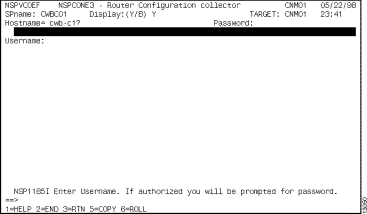
Step 3 In the Username field, type the userid for the router.
Step 4 In the Password field, type the enable password and press Enter.
Step 5 Press F10 to collect the router's configuration. Status messages are displayed as ISM requests and collects the router configuration.
Step 6 When you are notified that the router configuration for the router has been saved, press Enter. The configuration you collected is archived.
Step 7 Press F3 to terminate your enabled session to the router.
Complete the following tasks to display a list of archived configuration files:
Step 1 On the Router Status panel, position the cursor on the router name for which you want to view ISM management information and press F10. The Router Status with Options panel is displayed.
Step 2 In the Enter Option field, type 6 and press Enter. The Archived Router Configurations panel is displayed (Figure 5-21).

Step 3 To view the details of a configuration file, position the cursor on the record that you want to view and press F10. The Archived Configuration Details panel is displayed (Figure 5-22).
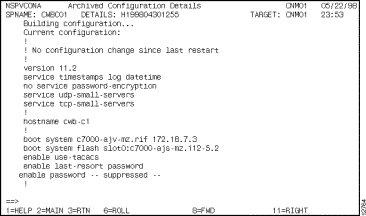
You can use the following methods to monitor the performance of a router:
For more information on setting up the router monitoring and threshold options, see the sections "Setting Up the Router Monitoring Interval" and "Setting Up the Router CPU and Memory Thresholds" in this chapter.
Once you have set the monitoring interval and CPU and memory threshold levels, ISM will measure the performance of the routers in your network using those values. The results are archived in the Router Performance History data set. Any ISM user can view the records archived for a specific router on the Router Performance History panel. If you are an ISM administrator, you can set the record wrap counts for the data set in the ISM Router Management setup. For more information about setting the record wrap counts, see the section "Changing the Database IDs and Maximum Record Counts".
Complete the following tasks to view performance history records for a specific router:
Step 1 On the Router Status panel, position the cursor over the router name for which you want to view ISM management information and press F10. The Router Status with Options panel is displayed.
Step 2 In the Enter Option field, type A and press Enter. The Router Performance History panel is displayed (Figure 5-23).
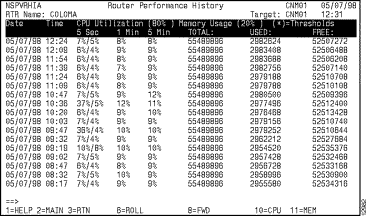
The Router Performance History panel shows CPU utilization and memory usage statistics. Threshold values are shown at the top of the display columns. If thresholds are exceeded, the line containing the alert is shown in yellow.
If you have enabled alert generation, alerts generated by a router that is being monitored by ISM are forwarded to the host by the service point configured in the router. You can enable ISM to generate alerts for routers, interfaces, and CMCCs when thresholds are exceeded. For information about enabling alert generation in ISM, see the section "Setting Up Router Alert Generation".
You can access NetView's Hardware Monitor Facility from within ISM to obtain a list of alerts generated by a specific router or router resource and forwarded to NetView. For more information on using the NetView Hardware Monitor Facility, refer to the appropriate NetView operations manual.
You can perform the following tasks to view hardware alerts and events:
Complete the following tasks to display the total count of events in NetView's hardware monitor:
Step 1 On the Router Status panel, position the cursor on the router name for which you want to view ISM management information and press F10. The Router Status with Options panel is displayed.
Step 2 In the Enter Option field, type 4 and press Enter. A NetView Hardware Monitor panel is displayed listing the most recent count of total events (in reverse chronological order) generated by the router (Figure 5-24).
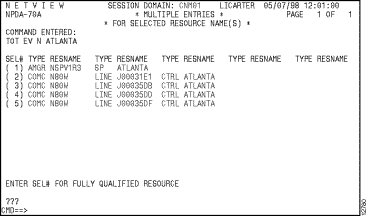
Step 1 On the Router Status panel, position the cursor over the router name for which you want to view ISM management information and press F10. The Router Status with Options panel is displayed.
Step 2 In the Enter Option field, type 8 and press Enter. A NetView Hardware Monitor panel is displayed listing the alert records generated by the router (Figure 5-25).
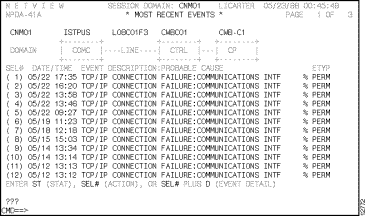
Complete the following tasks to issue commands to a router from the ISM main menu panel:
Step 1 On the ISM main menu panel, press the Tab key until the cursor is positioned in the Service Point Name field beside the * CMD option.
Step 2 Type in the service point name of the router and press Enter. The Router Command Interface panel (Figure 5-26) is displayed.
Step 3 To specify how to handle the output from the router command, specify one of the following options:
Step 4 In the Command Field, type the router command and press Enter.
Step 5 If a userid or password is required for the command that you entered, type the appropriate response at the corresponding prompt.
Step 6 To recall the last command that you issued, press F12.
Complete the following tasks to issue commands to a router from the Router Status panel:
Step 1 On the Router Status panel, position the cursor on the router name for which you want to view ISM management information and press F10. The Router Status with Options panel is displayed.
Step 2 In the Enter Option field, type 1 and press Enter. The Router Command Interface panel is displayed (Figure 5-26).
Step 3 To specify how to handle the output from the router command, specify one of the following options:
Step 4 In the Command Field, type the router command and press Enter.
Step 5 If a userid or password is required for the command that you entered, type the appropriate response at the corresponding prompt.
Step 6 To recall the last command that you issued, press F12.
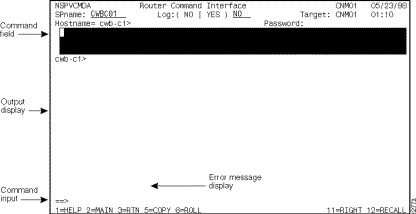
The Router Command Interface panel contains the following functional areas:
ISM provides a list of commonly used Cisco IOS software show commands that you can use to obtain additional information about a router. These commands are useful for monitoring and problem determination purposes. If you are an ISM administrator, you can add show commands to the Router Show Commands panel (Figure 5-27).
The following commands are displayed on the Router Show Commands panel:
Complete the following tasks to issue router show commands:
Step 1 On the Router Status panel, position the cursor on the router for which you want to view ISM management information and press F10. The Router Status with Options panel is displayed (Figure 5-7).
Step 2 To display the Router Show Commands panel, type B in the Enter Option field and press Enter. The Router Show Commands panel is displayed (Figure 5-27).
Step 3 To issue the command, type the number corresponding to the command and press Enter.

If you are an ISM administrator, you can add Cisco IOS software show commands to the Router Show Commands panel (Figure 5-27). These show commands must be supported by Cisco IOS Release 11.0 and later.
Complete the following tasks to add a Cisco IOS software show command to the Router Show Commands panel:
Step 1 On the Router Show Commands panel, press F4 to display an update panel. The Router Show Commands panel is displayed with data entry fields shown in green underline (Figure 5-28).
Step 2 Press the Tab key to move to the line number on which you want to add a show command.
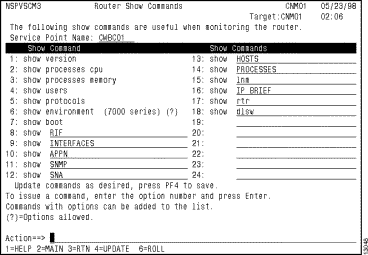
Step 3 In the data-entry field on the line, type the parameter or parameters that correspond to the command that you are adding (without the show keyword) and press F4.
Step 4 To return to the Router Show Commands panel, type B in the Enter Option field on the Router Status with Options panel (Figure 5-7) and press Enter. The Router Show Command panel is displayed with the command that you added.
The following commands are displayed on the Router Memory Dump Options panel (Figure 5-29):
Complete the following tasks to issue router memory commands:
Step 1 On the Router Status panel, position the cursor on the router name for which you want to view ISM management information and press F10. The Router Status with Options panel is displayed.
Step 2 To display the Router Memory Dump Commands panel, type D in the Enter Option field and press Enter. The Router Memory Dump Commands panel is displayed (Figure 5-29).
Step 3 To issue the command, type an X in the field corresponding to the memory command and press Enter.

Step 4 To view the output from the command, press F10. The Archived Router Memory Dump panel is displayed (Figure 5-30). Each time you run a command, a new record is created.

Step 5 From the Archived Router Memory Dump panel, you can perform the following tasks:
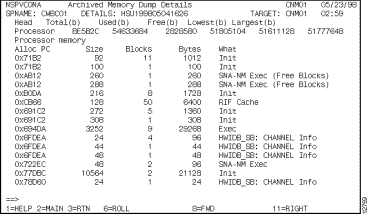
|
|